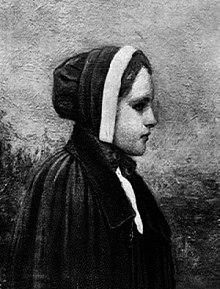Bridget Bishop
| Bridget Bishop | |
|---|---|
 |
|
| Born |
Bridget Magnus c. 1632 |
| Died | June 10, 1692 (aged 59–60) Salem, Massachusetts Bay Colony |
| Nationality | English |
| Occupation | Housewife |
| Criminal charge | Witchcraft, Conspiracy with the Devil (rehabilitated) |
| Criminal penalty | Execution by hanging |
| Criminal status | vacated |
Bridget Bishop (c. 1632 — June 10, 1692) was the first person executed for witchcraft during the Salem witch trials in 1692. All together about 72 people were accused and tried, while 20 were executed.
Bishop may have been accused because she owned one or more taverns, played shuffleboard, dressed in very provocative clothing, and was outspoken. One interpretation of the historical record suggests that she was a resident of Salem Town and thus not the tavern owner. Perhaps she did not know her accusers. This would be supported in her deposition in Salem Village before the authorities stating, "I never saw these persons before, nor I never was in this place before." The indictments against her clearly note that she was from "Salem" which meant Salem Town, as other indictments against residents of Salem Village specified their locations as such.
In the transcripts there is some indication of confusion between Sarah Bishop, wife of a tavern owner in Salem Village, and Bridget Bishop, not a tavern owner and a resident of Salem Town.
Bridget's maiden name seems to have been Magnus. She had one son from her marriage to Thomas Oliver, named Christian Oliver (sometimes spelled Chrestian), born 8 May 1667.
She was married three times. She married her first husband Samuel Wesselbe on 13 April 1660, at St. Mary-in-the-Marsh, Norwich, Norfolkshire, England.
Her second marriage on 26 July 1666 was to Thomas Oliver, a widower and prominent businessman. She was earlier accused of bewitching Thomas Oliver to death, but was acquitted for lack of evidence. Her last marriage circa 1687 was to Edward Bishop, a prosperous sawyer, whose family lived in Beverly.
Bishop was accused of bewitching five young women, Abigail Williams, Ann Putnam, Jr., Mercy Lewis, Mary Walcott, and Elizabeth Hubbard, on the date of her examination by the authorities, 19 April 1692.
A record was given of her trial by Cotton Mather in "The Wonders of the Invisible World." In his book, Mather recorded that several people testified against Bishop, stating that the shape of Bishop would pinch, choke or bite them. The shape also threatened to drown one victim if she did not write her name in a certain book. During the trial, anytime Bishop would look upon one of those supposed to be tortured by her, they would be immediately struck down and only her touch would revive them. More allegations were made during the trial including that of a woman saying that the apparition of Bishop tore her coat, upon further examination her coat was found to be torn in the exact spot. Mather mentions that the truth of these many accusations carried too much suspicion, however.
...
Wikipedia
